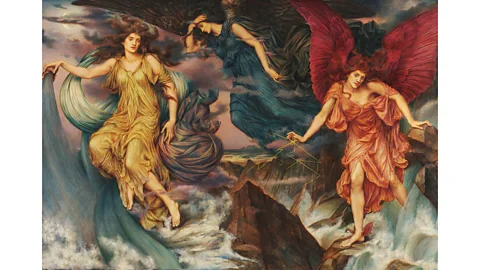Christened “Mary”, Evelyn later adopted her then-gender-neutral middle name, as women’s art was not taken seriously. “She wanted to be considered on the same level as her male peers,” says McMeakin. “We can assume a huge degree of self-possession and determination in her desire to become a professional artist,” she adds, making the point that even De Morgan’s mother opposed her career choice.
Technically, De Morgan was also a pioneer. She experimented with burnishing and rubbing gold pigment into her works to add depth and interest, and explored new painting techniques invented by her husband, made by grinding colours with glycerine and spirit. Stylistically, she was also ahead of her time. The unconventional use of pinks and purples, and the bold rings of rainbow-coloured light, prefigure the psychedelic painting styles of the 1970s, while her terrifying monsters would not look out of place in contemporary fantasy art.
While art history has tended to paint women as virgin mothers, objects of beauty or temptresses, De Morgan’s specifically female perspective recasts them as figures of hope that augur an alternative, brighter future. In Lux in Tenebris (light in darkness) (1895), for example, the female figure holds an olive branch in her right hand, offering a pathway to peace. In Death of the Dragon, the angel is surrounded by a magnificent rainbow: a symbol (along with the sky) of joy that denotes spiritual fulfilment and freedom, as well as the promise of an afterlife.
 Trustees of the De Morgan Foundation
Trustees of the De Morgan FoundationIt’s a mistake to think of works such as Death of the Dragon as “completely bleak”, argues McMeakin, noting that “often with [her] apocalyptic scenes, there is a glimmer of hope, or a part of the painting that is calm”. In many ways, Death of the Dragon is optimistic, expressing a sense that the war – the metaphorical dragon – is nearing its end, and that good can overcome evil. In this existential battle, De Morgan saw a place for her work. When she was aged just 17, she chastised herself for not painting enough. “Art is eternal, but life is short,” she wrote in her diary. “I will make up for it now, I have not a moment to lose.”